The tree hydrangea ingredibly is a luxurious decorative shrub, solidized by large snow-white inflorescences in the shape of a ball. Air lush flowers are pleased with their magnificence from the middle of the summer and almost to the first frosts.
In addition to an unusually attractive appearance, the plant has a common endurance and unpretentiousness to unfavorable environmental conditions. It is not surprising that this type of hydrangeas is particularly popular with the flower flows of the whole world. How to grow hydrangea inhibition on its site and what features of the perennial should be aware of and to take into account that the plant can develop as much as possible - read in this selection of material.
Hydrangea Tree Incredibly, Plant Description
- The type of hydrangea of \u200b\u200bthe tree belongs to the genus of hydrangea, the family of hydrangea.
- In a wild form, this leafy shrub grows in North America, in culture is common everywhere.
- The name of the appearance of the "tree" characterizes the appearance of the plant: it is high, up to 2-3-m, rounded shape shrub with dense weighing shoots.
- Tubular shoots are slightly pubescent, densely fruitful shaped egg-elongated (up to 20 cm) leaves, giving a shrub spectacular decorative appearance. From above, a sheet plate is painted in a bright rich green color, it has a jam-bluish tint below. Packers are long and thin, the list is opposite. Branched roots, superficial.
- The popularity and widespread dissemination of the hydrangea of \u200b\u200bthe tree is explained by the continuous abundant blossom of small (about 2 cm) of snow-white flowers collected in the inflorescence of the shield reaching from 15 to 30 cm in diameter and forming beautiful blooming "balls". Over time, snow-white inflorescences acquire an unusual lemon-greenish tint.
- The flowering of perennial begins in the middle of the summer and lasts until October. The fruit is a small (up to 3 mm) box, ripen in the second half of autumn.
- The hydrangea hydrangea grade was derived on the basis of the grade of the same type of "Anabel", so it often has a identical name - "Strong Annabel".
- Hydrangea tree Included is characterized by increased winter hardiness (withstands up to -30 0C), rapid ability to restore (for example, after severe frosts) and a high percentage of cutting of cuttings. In addition, strong shoots do not run from rain or gusty winds.
- This type of hydrangea has a rapid growth rate when branches per year grow to half a meter. At 4 years old, the perennial already has the form of a luxurious blooming shrub.
Hortensia Incredibly, where to buy?
Like any other varietal plants, hydrangea saplings Incredibly can be purchased in specialized flower shops or nurseries. There are seedlings on sale both with an open and closed root system (in pots or individual containers).
Choosing young hydrangea seedlings, attention should be paid to a number of mandatory features:
- The height of a full-fledged seedling should be at least half a meter.
- The number of shoots is at least 3.
- The kidneys on shoots should be large, elastic, not angry.
- The bark on semi-restless shoots should be without visible external damage.
- In the case of an open root system, the roots must be well developed (at least 25-30 cm long), not overheated, without signs of rotting.
- When buying a seedling in a container, it is important to clarify the seller of the dates for its landing (transplantation), since the recently transplanted plant badly "will respond" to another transplant and may not come.
- The best age of disembodied seedlings is 3-4 years.
Acquired seedlings with a closed root system are often ensured by fertilizers of prolonged action, which means they do not need additional feeding the first year after landing. The advantage of plants in pots is the fast survival rate in a new place and the possibility of planting the plant into the ground throughout the growing season.
Reviews of Hydrangea Holders Includes are reduced to a positive evaluation of its external data, combined with the general unpretentiousness of the plant in the garden. Such advantages cannot not attract professional florists and ordinary flowers lovers.
Popular among flower water recently considered such a variety as g ortentization Incredibly Blass - Spanish tosleep, up to one and a half meters with large pink inflorescences, acquired gradually saturated dark raspberry shade.
Hydrangea tree Incredibly, planting features
The tree hydrangea will be able to effectively decorate any corner of the garden or the household site only under the condition of its competent landing.
At the same time, it is important to initially choose the place for landing a perennial shrub, because hydrangea reacts poorly to a transplant, especially in adulthood.
Hydrangea Planting Terms Includes
- Choose a place for planting hydrangea should be given to its preferences. So, a light-loving plant needs a sunny, protected from open winds place or in a light openwork fellow. The best option is the presence of the sun in the morning and in the evening, and the gracious shadow in a hot noon.
- There are also certain requirements and to the composition of the soil. Hydrangea will be able to develop as much as possible on the nutritional, loose, breathable, drunken soil with a weakly acidic reaction (with a pH level - 5). Alkaline soil The plant also transfers, but it is better to artificially "acidify it", adding peat, sheet compost or rewindingly chew. In addition to the natural organic, an ammonium saltper, sulfate potassium or citric acid (in the form of a solution) can be used as a "acider".
- As for the landing time, the hortensia of the incredibur is planted in early spring or autumn. In the cold regions with early winter landing of perennials, it is recommended to spend only in spring time so that the seedlings can better root and adapt to the onset of winter. If still had to land the plant in the fall, it is necessary to do this in the first half of the fall, with the obligatory shelter of the seedling for the winter period.
Agrotechnology landing hydrangea ingrediburs
- Hydrangea seedlings with an open root system are planted immediately after purchase. If there is a need to postpone with landing, seedlings are stored in a dark cool (from 0 to +3 0C) place, providing constant moisturizing roots.
- Pre-present preparation includes the processing of the site: Popile, fertilizer and removal of weeds. After that, they prepare the landing pit, the dimensions of which depend on the size of the root system or the earthen koma seedlings. Average pockets of the pit - about half a meter in all directions.
- The tree hydrangea is favorably responded to the fertile soil, so mixed components are added when planting a pit: sand, leaf humus (compost) and turf. Poor soil also add 50 g of superphosphate and potassium-containing fertilizers.
- Immediately before planting the roots, the seedlings carefully examine and remove all the raids, broken or too long (all roots must be about the same length). Tangled or long roots of container seedlings are also slightly cut. At the spring landing is also cutting and annual shoots on 3-4 kidneys.
- Improve the survival process helps the root exposure in the growth stimulator solution (for example, in heteroacexine). Put the roots from 5 to 20 hours, after which they immediately plant in the ground.
- The seedling vertically exhibit on the earthly moistened hilly and fall asleep by the soil mixture, periodically sealing it in order to avoid the formation of emptiness. In this case, the root neck is not plugged, leaving at the ground level.
- After planting, the plant is abundantly watered with water and mulched peat (or humus). First time after landing, the culture needs to be shared from the scoring sunlight and protection from the gusty winds.
- When group landings, it is important to observe the interval between seedlings, which should be at least 80-100 cm.
Hydrangea Tree Incredibly, Care Features
So that a perennial flowering plant pleased those surrounding brown long blossoms, it is important to care for the shrub correctly. Strong dense shoots of hydrangea ingredibly do not give the shrub to fall apart and do not need a garter. Otherwise, care for the perennial is carried out according to the usual rules of agricultural engineering.
Watering and loosening hydrangea Incredit
- Moofable hydrangea needs regular abundant irrigation. The average irrigation rate is 1 time per week 2-3 buckets of water under the bush. More accurate indicators depend on the size of the bush, the climatic conditions of the region, natural precipitation and the presence of a mulching layer.
- For irrigations, it is best to use soft water outdoor water temperature. Watering is carried out in the morning or evening. Watering the plant is necessary under the root, without water from the inflorescences.
- When moisture lack of moisture, the plant begins to fade, inflore the inflorescence, and the leaves are imposed. And in the case of a systematic lack of moisture, the flowers of hydrangeas will be fine with each year, and the development of a shrub will be internally.
- Experienced flowers are recommended to make periodic watering under the root of a weak solution of potassium permanganate. Such procedures ensure the strength and flexibility of the branches of the hydrangea. Sometimes, after several such irregularities, the inflorescences acquire a beautiful pink shade.
- After irrigated, the ground around the shrub is loosened to a depth of no more than 4-5 cm (given the surface location of the roots) or mulch. The mulch is perfectly suitable sour peat, sawdust or wood chips. The recommended layer of mulch is 6-8 cm. When mulching a priority circle, a mulching material should not touch the hydrangea trunk, it is better to place it 2-3 cm further.
Protecting Hydrangea Incredibly
- The shrub of the tree hydrangea ingrediburs needs an annual trimming. Pruning is different: forming, sanitary and rejuvenating.
- Forming trimming is carried out from the 1st year after planting a seedlings. The main purpose of this type of trimming is the formation of a low and decorative Habitus Hydrangea Shrub. For this, all shoots are shortened first by 10-15 cm, with each year reducing this indicator to 2-5 cm.
- Sanitary trim involves removing damaged, frostbed or dry escapes. Also curly too thickened or interfering with other branches.
- The tree hydrangea ingredibly blooms on the shoots of the current year, so the plant is not afraid of a strong rejuvenating trimming of old semi-respected shoots. An early spring (before the start of the depotation) of the flower was recommended to carry out a cardinal "haircut" of perennials, cutting all the shoots to almost the base (leaving 30-40 cm). Cut branches are used as cuttings for culture reproduction. After this procedure, strong shoots that give major beautiful inflorescences are formed.
- In the autumn, on the eve of the winter, the blurred inflorescences are cut off and shorten the shoots to a level of 30 cm. This technique provokes the best development of root shoots and protects the plant from freezing in winter.
Fighting Diseases and Pests Hydrangea Included
- In most cases, the hydrangea is a tree resistant to most diseases and is practically not attacked by pests. Only incorrect care and adverse weather conditions can provoke the development of similar troubles.
- If hydrangea grows on alkaline soil, often such plants suffer from chlorosis. The first sign of the disease is fading foliage.
- Occasionally, the green part of the plant may be amazed by flourous dew or spotting foliage (anthyraznosis).
- To protect the blooming perennials use fungicidal preparations, such as "Sorrow", "Maxim", "Chorus", "Svitch", etc.
- In addition to diseases, a spider tick can parasitate on the plant. Then they will need such insecticidal preparations as "phytodeter" or "intavir".
Supporting Hydrangea Incredibly
- The tree hydrangea will delight the case of inflorescences and the lush of the shrub, if periodically fertilize the ground on the flower bed.
- For the entire growing season season, it is enough to carry out about 3-4-podcoc.
- The first feeding comes from the spring time, the period of formation of shoots and green mass growth. During this period, a complex mineral fertilizer is used with nitrogen, potassium and phosphorus.
- The second feeder is carried out in the period of the so-called. Bootonization. During this period, it is best to use superphosphate or sulfur potassium.
- The following feeder is carried out at the end of the summer fertilizers containing potassium. You can also use any organic complexes (bird litter, compost, reworked manure).
- In the fall, fertilizers are already inappropriate, as the plant begins to prepare for the rest period.
Preparation for winter hydrangea Includes
- Hydrangea Tree Incredibly is considered a winter-hardy plant relating to the 5th zone of frost resistance. In this regard, adults of the hydrangea bushes do not need additional shelter.
- Only young hydrangeas of hydrangea ingrediblib, who have not reached 3-4 years of hydrangea are needed to protect and protect. For this, the rolling circle is mulched and covered with a snack or nonwoven material. In the spring, as soon as the threat of return freezers, the shelter is removed. Do it better on a cloudy day to avoid sunburn.
- Sometimes, in winter, the shoots of hydrangea can suffer from severe frosts, but in the spring they will quickly grow. And taking into account the fact that inflorescences are formed on young shoots, bloom will necessarily come.
The reproduction of hydrangea inhibition
Like most other shrubs, hydrangea is multiplied with cuttings, tanks or the division of the bush. Seeds or vaccination, the tree hydrangea practically do not multiply, due to the duration and complexity of the process.
Consider the advantages and disadvantages of each method.
- Shining - One of the most common ways, the success and accessibility of which almost reaches 100% marks. The cuttings are cut in the late spring or early summer, using unreserved young shoots, up to 15 cm long (most often the tops or side shoots with a piece of old branch). The cut is made at right angles. From below, all the leaves on the sections of shoots are removed, processed in the growth stimulator, after which it is planted in a nourishing soil substrate (you can use a mixture of sand and peat). For quick rooting, it is best to build a mini-greenhouse, closing the container (or plastic bottle) with glass or film. The wet greenhouse microclimate will contribute to the rapid formation of the roots. Care for cuttings during this period includes: watering, venting, good lighting and positive temperature. The rooted seedlings transplanted at a permanent place in about a year. The first 2-3 years for the winter young seedlings are covered. The flowering of hydrangea grown by cuttings occurs about the 4-5th year of the plant's life.
- Division bush You can exercise in spring or autumn, during a shrub transplant. For this, the hydrangea bush is digging, divided (acute shovel) into several full-fledged parts so that each decene has root and renewal kidney. After this "simple" procedure, the Delive Delivery of the tree hydrangea is planted separately, on the planned place.
- Shrubs, older than 1-2 years, can also be breed using owls - The lower escapes that are flexing to the ground and cheer (it is better to fasten the metal bracket), leaving only its top (15-20 cm). In the place where the escape was covered with the earth, the roots should be formed. It is important to regularly moisten the place of "consolidation" of escape. In the spring (or autumn), the rooted tanks are separated from the "Parental" bush and planted separately in the half-sense.
Application of tree hydrangea Includes
- The spectacular decorative appearance of the shrub makes his favorites for many flower and landscape designers.
- Hydrangea The tree Incredibly looks exquisitely as in group landings, forming a flowering alley, and in a single landing, as a central element of flower beds.
- Beautiful snow-white bushes of flowering hydrangea in contrast compositions with conifers or other decorative shrubs.
- If the hydrangea is planted onto the flower bed, it is best to post them in the background so that they do not cover the rest, lower flowers.
- Large compounds of hydrangea are used on a cut, as well as to create dried bouquets. For the correct workpiece of dry inflorescences, the shoots of hydrangea are cut immediately after the blooming of flowers, after which they are placed in a dry dark place, tumming down "head" for cutting down.
- Interesting the fact of artificial change in the color of white inflorescences on the pink or blue shade. For this, the plant is watered with solid dyes (aluminum sulfate, potassium permanganate), which can be purchased in the fertilizer sales department.
Thus, the tree hydrangea is an incentive - an unpretentious and highly decorative plant, which can easily grow even a novice flower descender - an amateur. A sophisticated beauty lush the blooming shrub will be a real remuneration for all the efforts.

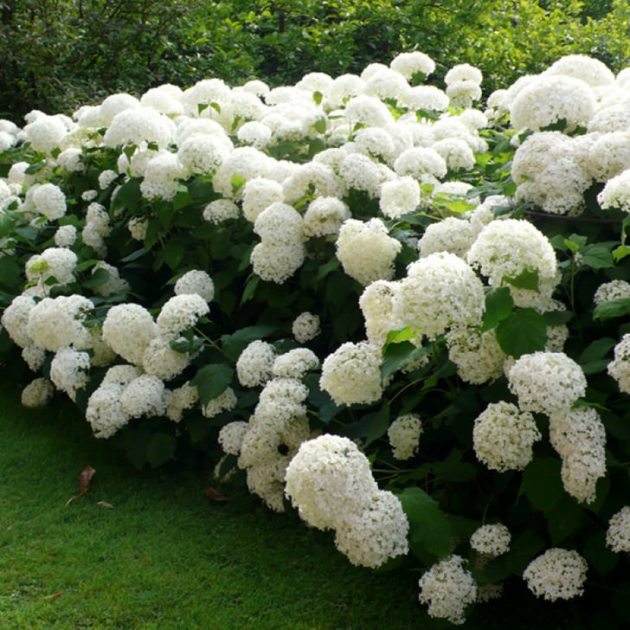


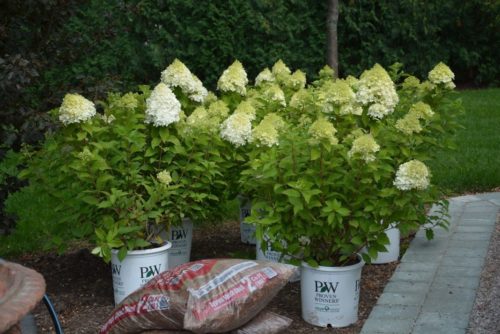
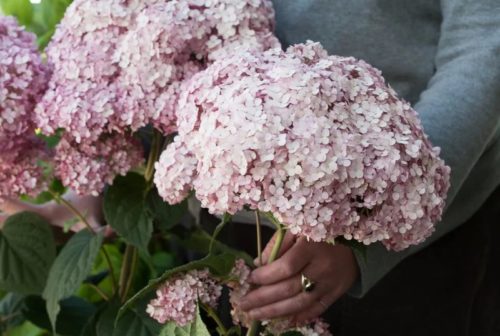
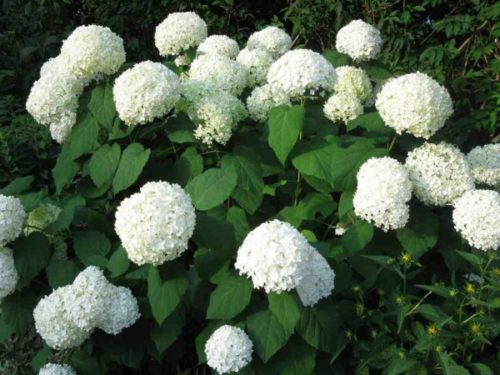


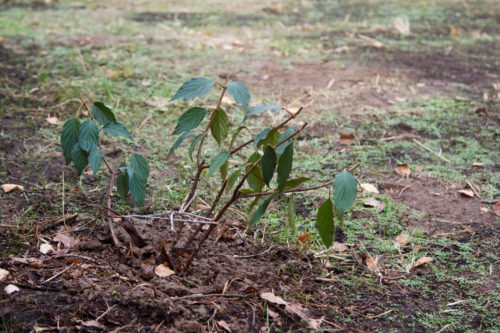
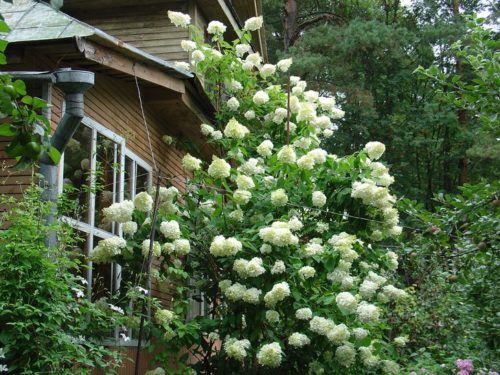
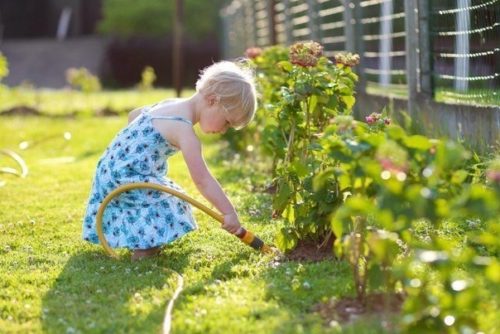
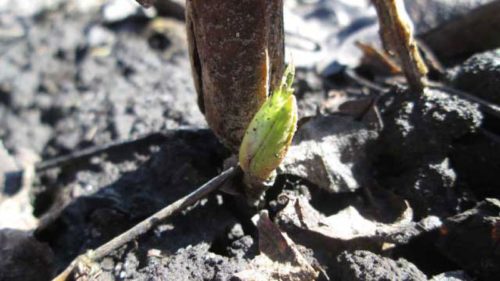
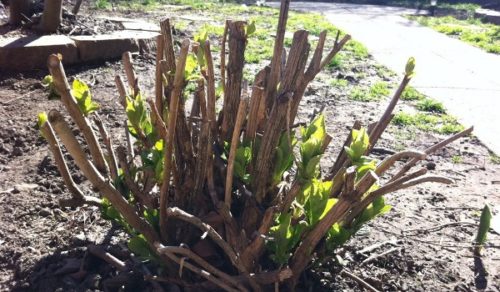
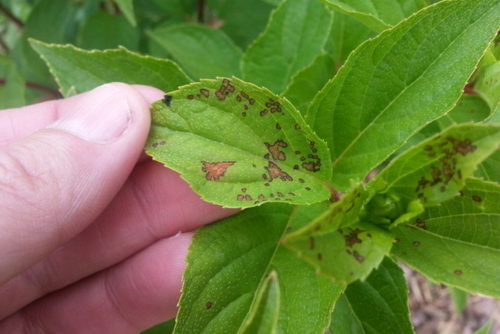


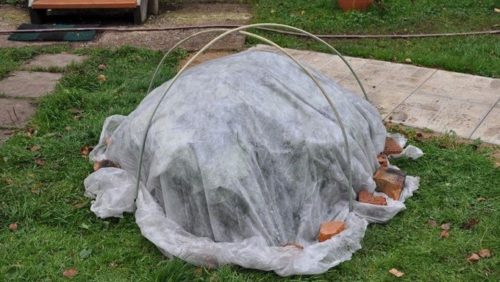
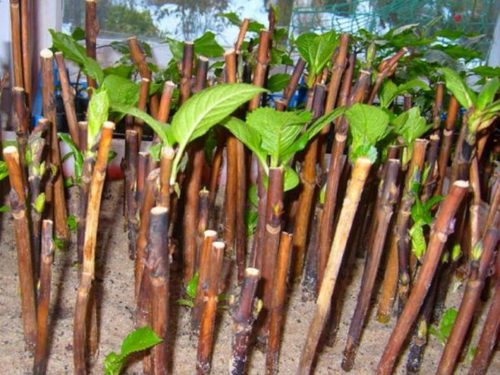




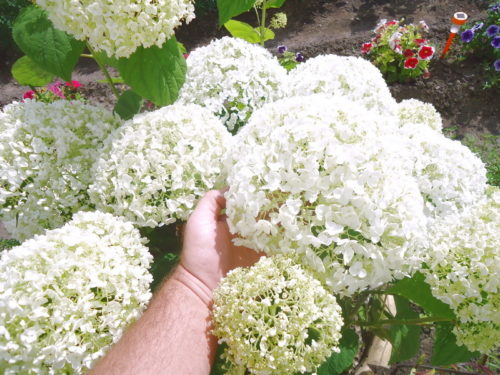
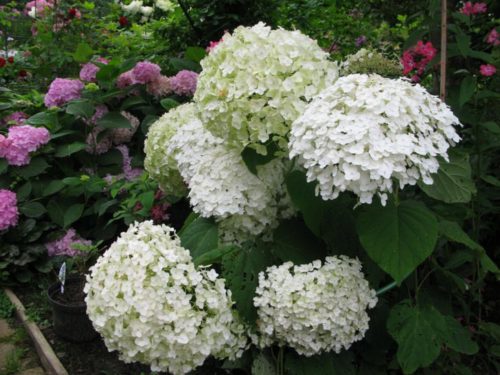












 Start a discussion ...
Start a discussion ...